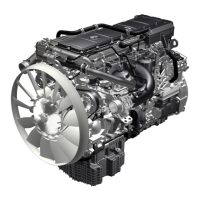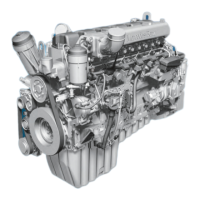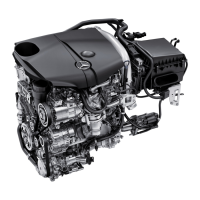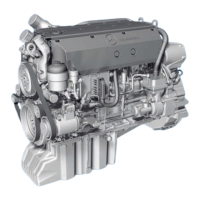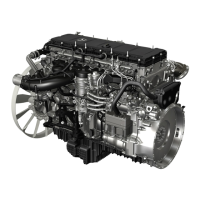
Do you have a question about the Mercedes-Benz OM 470 Euro VI and is the answer not in the manual?
| Brand | Mercedes-Benz |
|---|---|
| Model | OM 470 Euro VI |
| Category | Engine |
| Language | English |
Defines the engine system and outlines Daimler's environmental protection policy.
Details assembly equipment coverage and the importance of genuine Mercedes-Benz parts.
Warns against modifying engine output and explains safety/emergency running programs.
Covers correct installation, usage, modifications, and implied warranty.
Explains stored technical data and refers to further applicable documents.
Emphasizes the necessity of using qualified workshops for engine work.
Describes the engine brake functionality and the common rail diesel injection system.
Identifies key components of the OM 471 engine via a diagram and list.
Identifies key components of the exhaust gas aftertreatment system via a diagram.
Describes the electronic engine management system and its control units.
Details the MCM's location and its various functions in engine control.
Explains the CPC's role as an interface and its functions in vehicle control.
Covers the ACM's functions in regulating the exhaust gas aftertreatment system.
Describes the BlueTec® system's operation and emission reduction methods.
Explains the purpose and function of the exhaust gas recirculation system.
Introduces warning and indicator lamps, their importance, and display formats.
Highlights safety measures and consequences of ignoring warning lamps.
Provides safety notes on electronic systems and the purpose of warning stickers.
Covers EMC certification and the use of the diagnostics connection.
Emphasizes staff qualifications and the need for qualified specialist workshops.
Provides crucial safety instructions for lifting and transporting the engine.
Outlines requirements for proper engine system installation.
Covers initial engine oil, electronic oil level measurement, and message displays.
Details dipstick oil checks and inspection of decoupling element, coolant, and fuel levels.
Explains how to start the engine safely, including oil pressure checks.
Covers safe engine stopping methods and using external start/stop buttons.
Describes the operation of continuous brakes, engine brakes, and retarders.
Explains how idling speed is regulated and how to set working speed.
Details climate control use and monitoring of charge current and engine management.
Covers oil pressure warnings, operating restrictions, and rev counter information.
Explains AdBlue®/DEF level monitoring and the function of warning/indicator lamps.
Guides running-in procedures and lists factors affecting fuel consumption.
Provides tips for fuel-efficient driving and explains environmental notes.
Covers diesel particle filter safety, manual, and automatic regeneration processes.
Details manual regeneration steps and the process for changing the diesel particle filter.
Provides information on AdBlue® and engine oil consumption rates.
Explains warning buzzer conditions and crucial safety steps for handling fuels.
Covers AdBlue®/DEF safety, storage, and pre-refuelling checks.
Provides advice for winter operation, including oil, coolant, and preheating.
Details jump-starting safety precautions, battery handling, and procedures.
Explains the use of diesel fuels suitable for low temperatures and related safety.
Covers safety, legal regulations, and warnings before maintenance or repair.
Discusses maintenance scope, approved parts, and information access (WIS).
Covers safety, handling, storage of service products, and engine oil specifications.
Details engine oil change intervals, topping up, and oil miscibility guidelines.
Provides safety information for coolant systems and diesel fuel handling.
Explains fuel grade, water content, and winter diesel fuel properties.
Covers AdBlue®/DEF safety, contact precautions, and handling at different temperatures.
Discusses AdBlue®/DEF purity, storage, disposal, and engine cleaning guidelines.
Provides instructions and safety warnings for high-pressure and engine cleaning.
Covers general decommissioning, battery storage, and recharging advice.
Details measures for decommissioning the engine/vehicle for up to 6 months.
Outlines requirements for decommissioning the engine/vehicle for over 6 months.
Provides crucial safety warnings for working in the engine compartment.
Explains how to use the external engine start/stop button.
Details safe engine starting and stopping methods, including key and external button use.
Provides step-by-step instructions for bleeding and draining the fuel system.
Explains how to drain water from the fuel prefilter and fuel filter.
Covers the importance of electrical fuses, replacement warnings, and circuit protection.
Details critical safety precautions for jump-starting and handling batteries.
Provides step-by-step guides for connecting and disconnecting jump leads.
Addresses problems with the drive pinion, engine starting, and low temperature issues.
Covers causes and solutions for engines stopping, emergency mode, and irregular operation.
Explains causes of poor engine power and activated operating restrictions.
Addresses issues with tractive power, braking, fuel consumption, and engine overheating.
Covers problems with indicator lamps, engine knocking, and abnormal sounds.
Details the procedure and safety warnings for replacing the poly-V-belt.
Explains the engine and exhaust aftertreatment identification plates and the data card.
Provides dimensional data and weight specifications for the engines.
Details engine types, combustion, cylinders, bore, stroke, capacity, and performance.
Lists fluid capacities, service product recommendations, and torque specifications.
Covers specifications for exhaust gas aftertreatment components and the air dryer.
Provides links for further information about Mercedes-Benz engines and Daimler AG.
Details contact information for the documentation team and the assembly manufacturer.

